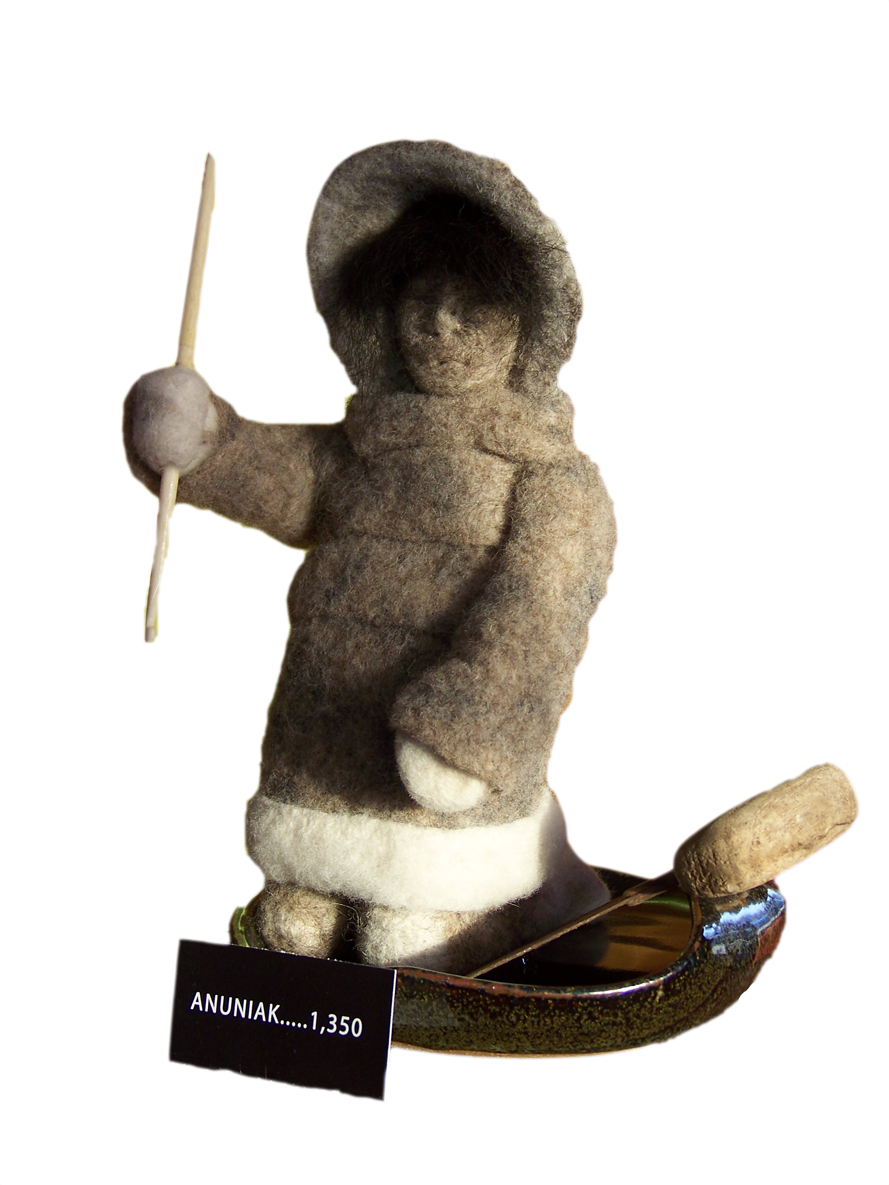“First Alaskans” is artist Pamela “Asiak” Nolcini’s name for her exhibit that debuted as a First Friday exhibit at Photo Depot this month. Not ‘First Alaskans’ as in pioneers of the state’s oil industry. Not ‘First Alaskans’ as in homesteaders looking for a piece of land where they could build a home. Not ‘First Alaskans’ as the rush of individuals who journeyed north with dreams of gold.
These are ‘First Alaskans’ born of Nolcini’s Eskimo heritage. The sculpted felt figures bear names reflecting that heritage and the personalities Nolcini’s creative spirit has uncovered.
There’s Anuniak, “one who hunts.” The figure kneels on a ceramic plate, an old ulu by his side. In his upraised hand is an ivory hunting implement Nolcini carved. Asiavik, a mother and child shape, draws its name, meaning “a new blueberry,” from berries Nolcini used to color the felt. Chugiak, standing with hands clasped, means “mountain.”
Each one is a story in itself, told by its shape, the combination of fibers used in its creation, the way Nolcini has chosen to present it and the name she has given.
Only Anuniak has a face. For the others, the lack of facial features captures attention.
“A lot of times, less is more,” said Nolcini. “People can put their own feelings, their own perceptions, their own faces on them. … It gives depth as far as emotionally and physically, too, I think.”
For Nolcini, however, the lack of a face carries a deep and intentional meaning.
“I feel it represents my people and their place in society, because we’re faceless. Most people just pass us by on the street,” said Nolcini. “I want people to connect to our culture by looking at something that, hopefully, is beautiful to them, and then to see that there’s no face can represent a connection, or a non-connection if you will.”
Born in Alaska, Nolcini was raised in the village of Alexander Creek. Her family harvested food from the land and made most of what was needed. Nolcini was home-
schooled and spent summers fishing with the family in Bristol Bay “as soon as I could pull fish from the net and drag them to the beach,” she said.
For the past eight years, Nolcini — her Eskimo name, Asiak, was given to her by her father and means “nice little woman” — has lived near Pt. McKenzie.
Through it all, art has been an important part of her life.
“I started as a young kid … drawing with pencils, ink, pastels. I used water colors, but didn’t use a lot of oils,” she said.
Photography captured her interest, as did creating clay sculptures. That led to creating fantasy dolls and a study of Eskimo faces. Using wool fibers for hair, Nolcini became engrossed with the properties of wool.
“That’s what pulled me into using wool full-time,” she said. “It’s such a versatile material and I believe as a society we need to get back to more natural things that we can actually lay hands on and utilize. … It’s a connection that’s ancient.”
The dolls took shape as Nolcini began experimenting with needle felting.
“It was a very, very humble effort, but I kept after it because I had a desire to do it,” she said. “It took me about two years of immersing myself in it to actually develop to a point where I liked the look. … It’s an ongoing process.”
Paired with the dolls are interesting pieces Nolcini has found in her wanderings. Items from the beach. Scraps from an abandoned cannery. Pieces that have history as well as articles speaking of more recent times. Combining them “really refreshes my spirit,” said the artist.
“Some people don’t like my primitive images paired with modern things like ceramics and metals, but to me … that is the essence of us, when I think about my culture,” said Nolcini.
Using some of her found objects, window frames, Nolcini is contemplating her next artistic endeavor under the working title of “windows of the soul.”
“I try to keep my hands as tools to interpret what I’m feeling,” she said. “Many times I felt like the character or spirit of the Eskimo develops itself as a way of coming out through a birthing process. … You try to shape it and all of a sudden, it takes over and becomes an individual entity and it’s like you’ve born a child.”
Whether crayons, sculpted fibers or recycled window frames, Nolcini’s goal is the same: to give her people a place.
“I pray every day for God to use my hands to bring forth the People, my ‘First Alaskans,’” she said.
McKibben Jackinsky can be reached at mckibben.jackinsky@homernews.com.


